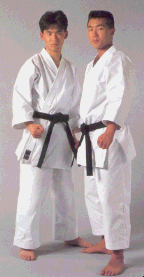

Very traditional karate students keep their uniforms free from patches, buttons and writing. Their gis are also usually white, only. This is not to say it is wrong if you happen to be someone with patches on your gi or have a different color(s) than white. To each his own!!
The gi should be treated with the same amount of respect as the dojo, as your teacher, as yourself. Your gi is your outward appearance for your art. The gi should not have holes or be dirty. The holes can be repaired and dirt should be washed out. The gi should NEVER be left in a pile. When not being worn or washed, it should be hung up, folded or rolled up and tied with the belt.
Now, a word about belt color. There is a somewhat "standard" progression in belt colors, but many schools add their own colors into the mix. This usual progression appears to be: White, Yellow, Orange, Green, Blue, Purple, Brown and then Black. There are then up to 10 levels of black belt. When you compare belt color with other martial art practioners, be aware that your school may or may not use the same color progression as another school. The belt colors (other than white and black) are really only valid within the walls of your own dojo.
Speaking of white and black, these are the only colors of the belt that are "original". The entire concept of adding various colors to designate rank was added when karate began being taught to US servicemen in Japan. The original idea of a "black" belt was due to the use the belt got and its age. A student would start his training with a white belt. Over the years, as the student trained and practiced, sweated and bled, the belt would get dirtier and dirtier. Eventually, the belt would be "black". If the student trained long enough for the belt to get this color, they probably knew what they were doing (or they trained in a REALLY dirty dojo).
 Back
Back